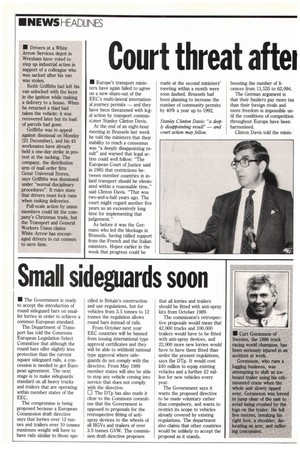Small sideguards soon
Page 6

If you've noticed an error in this article please click here to report it so we can fix it.
• The Government is ready to accept the introduction of round sideguard bars on smaller lorries in order to achieve a common European standard.
The Department of Transport has told the Commons European Legislation Select Committee that although the round bars offer slightly less protection than the current square sideguard rails, a concession is needed to get European agreement. The next stage is to make sideguards standard on all heavy trucks and trailers that are operating within member states of the EEC.
The compromise is being proposed because a European Commission draft directive says that lorries over 12 tonnes and trailers over 10 tonnes maximum weight will have to have rails similar to those spe
cified in Britain's construction and use regulations, but for vehicles from 3.5 tonnes to 12 tonnes the regulation allows round bars instead of rails.
From October next year EEC countries will be banned from issuing international type approval certificates and they will be able to withhold national type approval where sideguards do not comply with the directive. From May 1989 member states will also be able to stop any vehicle coming into service that does not comply with the directive.
El The DTp has also made it clear to the Commons committee that the Government is opposed to proposals for the retrospective fitting of antispray devices to the wheels of all HGVs and trailers of over 3.5 tonnes GVW. The commission draft directive proposes that all lorries and trailers should be fitted with anti-spray kits from October 1989.
The commission's retrospective proposals would mean that 42,000 trucks and 100,000 trailers would have to be fitted with anti-spray devices, and 22,000 more new lorries would have to have them fitted than under the present regulations, says the DTp. It would cost £40 million to equip existing vehicles and a further £2 million for new vehicles every year.
The Government says it wants the proposed directive to be made voluntary rather than compulsory, and wants to restrict its scope to vehicles already covered by existing regulations. The department also claims that other countries would be unlikely to accept the proposal as it stands.








































































































